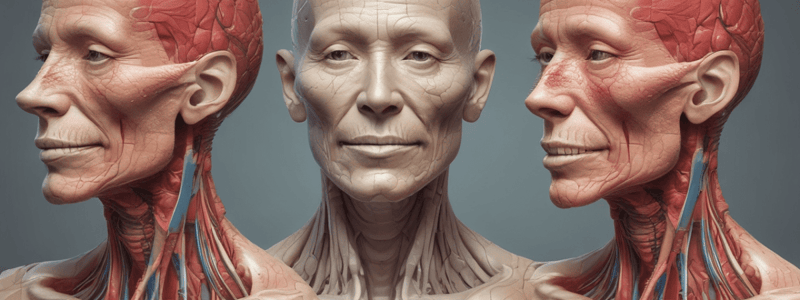Podcast
Questions and Answers
Which of the following is NOT a body cavity?
Which of the following is NOT a body cavity?
- Pelvic cavity
- Abdominal cavity
- Orbital cavity (correct)
- Thoracic cavity
What is the term used to describe a position where the patient is lying face down?
What is the term used to describe a position where the patient is lying face down?
- Prone (correct)
- Semi-fowler
- Fowler
- Supine
Which term is used to describe a movement away from the midline of the body?
Which term is used to describe a movement away from the midline of the body?
- Abduction (correct)
- Adduction
- Flexion
- Extension
What is the term used to describe a position where the patient is sitting at a 45° angle?
What is the term used to describe a position where the patient is sitting at a 45° angle?
Which term is used to describe a structure that is closer to the trunk or central part of the body?
Which term is used to describe a structure that is closer to the trunk or central part of the body?
Which term is used to describe a structure that is closer to the midline of the body?
Which term is used to describe a structure that is closer to the midline of the body?
Study Notes
- Topographic Anatomy includes transverse, frontal, and sagittal planes dividing the body into specific areas with names like dorsal (posterior) and ventral (anterior) cavities such as cranial, spinal, thoracic, abdominal, and pelvic cavities.
- Directional terms like superior (above), inferior (below), lateral (away from midline), medial (closer to midline), proximal (closer to body structures), and distal (farther from trunk) are crucial in describing body positions.
- Understanding terms like superficial, deep, anterior, posterior, palmar, and plantar is essential for accurate documentation and patient reports.
- Range of motion involves movements like flexion (moving towards trunk), extension (returning to anatomical position), abduction (away from midline), and adduction (towards midline).
- Patient positions like prone (face down), supine (face up), fowler (sitting with varying knee positions), semi-fowler (sitting at a 45° angle), and recovery position (left side with head on bottom arm) are important for patient care and comfort.
Studying That Suits You
Use AI to generate personalized quizzes and flashcards to suit your learning preferences.
Description
Test your knowledge of topographic anatomy, directional terms, body positions, and patient positions. Learn about planes, cavities, and crucial anatomical terms for accurate patient documentation and care.




